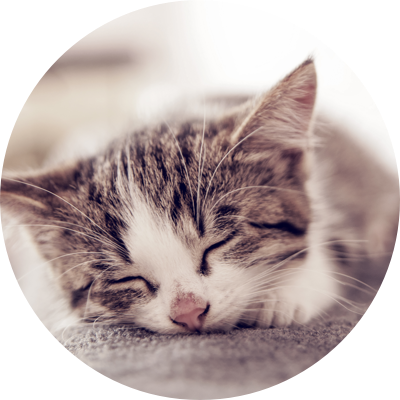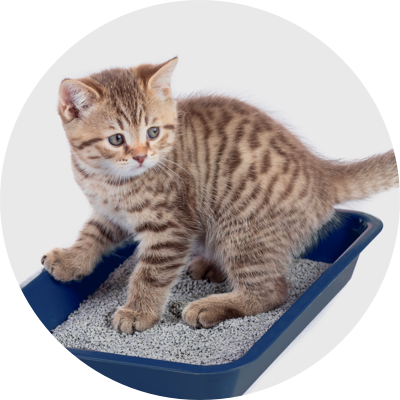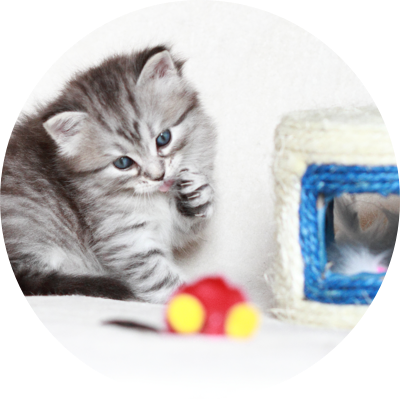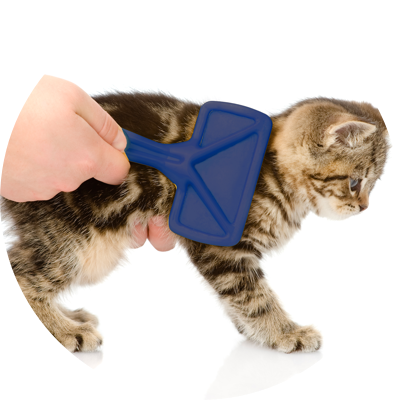YOU’RE ABOUT TO RECEIVE YOUR NEW KITTEN, how exciting!
Here we explain what you need to think about before their arrival
Over the coming days both of you are going to experience big changes, which may sometimes involve feeling nervous and disorientated. With that in mind, help them and make their arrival as easy as possible, so that they can get used to their new surroundings.
PREPARATIONS FOR THEIR ARRIVAL
There are some basic things that you should have before your kitten arrives home:
Make sure that they will live in a safe place
INSIDE THE HOME

INSIDE THE HOME
Remove objects that may cause them harm, for example cables and wires, and be careful about where you keep harmful products.
Remember that they are in a new environment and they will want to explore and play with everything within their reach. For this reason, if you think that some object or other may get damaged, it will be better that you leave it out of their reach.
OUTSIDE

OUTSIDE
To begin with, avoid letting your kitten go outdoors until they have got used to their new home, especially if they have not yet had all their vaccinations. If your kitten has access to a garden or a terrace, make sure that there are no holes or gaps through which they could escape or fall from a height.
Basic know-how
Felines are extraordinary and very particular animals, with specific and individual needs that have to be met to keep them in the best of health. Cats retain their reproduction, hunting and social communication instincts. In addition, they are nocturnal, very active and territorial, to a greater or lesser extent. To avoid health and behavioural problems, we should provide them with things that allow them to develop their natural and instinctive behaviour.
ARRIVING HOME

Generally speaking, arriving at a new place is a stressful experience whether your cat is an adult or a kitten. Ideally you should create a small and secure space to which other animals do not have access, if you have any. You will be able to locate all the essential items in that space: water bowl, food bowl, bed, blanket, litter tray and the odd toy.

Explain to the children how they need to treat them: teach them to play with the kitten, but that it is better to use toys rather than their hands, and also to respect their need for peace and quiet. Especially over the first few days, supervise all the time that the children and the kitten are together.

Before introducing them, it is advisable to visit the vet to check the state of their health and to have their first anti-parasite treatments and vaccinations done. In general, cats are very territorial and introductions to other animals in a closed environment should happen very gradually and under supervision.
If your kitten is in its socialisation period (between 2 and 7 weeks old), their learning will be easier and they will get used to other species and animals more naturally. If they are outside of this period, introductions should be initiated from inside the pet carrier, and then later you can carefully increase contact time, taking small steps. It is important that they have space to be able to react and hide in case they feel threatened

To ensure that your kitten responds appropriately to your requirements, you should try to offer them a positive experience and provide them with a suitable environment in which their natural instincts can best develop.
In certain situations, using some kind of unpleasant stimulus, which does not involve any type of harm, can turn out to be useful. Squirting them with water from a sprayer at the exact moment when they exhibit undesirable behaviour can be effective.

Allow your kitten to get to know their new surroundings. Leave them to explore the different rooms, at their own pace and without telling them off. Allow them to return to their safe area whenever they need to. Once you have got through this period, you will notice that they roam the house quite freely and choose their own areas as they please. This is a good time to widen their area and spread their belongings around different parts of the house, and then show them where they are located.

Cats are very meticulous in their hygiene habits, so establishing a grooming area is vitally important. Place one or several litter trays with clean sand in a quiet, well-ventilated spot that is not in a busy area of the house. Show them where this spot is - felines learn very quickly and once they are used to their sand tray, they will use it systematically. There are countless litter trays on the market. Choose the one that best suits your home and your kitten’s needs.

Prepare the necessary belongings for the journey (litter tray, food and water bowls, pet carrier and documentation, if required). Bear in mind that many cats experience travel sickness in cars, so you should not give them anything to eat before the journey. Your pet carrier is an essential accessory for carrying your kitten from one place to another (vet, journeys, house moves, etc.). It should be one in which they can feel safe and protected and in which they can move and stretch perfectly easily, and have no problems sleeping. Rigid pet carriers are an ideal option for such instances, and they should always be well secured in the car, preferably on the floor.
To make it easier for them to adapt, get your kitten used to their carrier for a few days beforehand. Pop in some of their most familiar items and even a reward that will motivate them.
IDENTIFACATION

MICROCHIP
It is a simple device that the vet implants below the skin, on the left-hand side of their neck or on their withers. It has a numerical code on which all of your details and those of your kitten are stored. Remember to update the details on the microchip should any of your personal details change.
If your kitten gets lost, their microchip will make it easier to find them. Whether or not it is obligatory will depend on the Autonomous Community in which you live, unless you are travelling abroad. If this is the case, the microchip and their passport and rabies vaccination are mandatory all over the country.

TAG
It is advisable that you also hang a tag off your kitten’s collar, with their name and your telephone number, in order to find you quickly should they get lost. Furthermore, in some autonomous communities it is obligatory.
Here, the use of easy-opening collars is recommended to avoid them getting caught anywhere, and always without a bell. Bells can cause your cat to become nervous and stressed, and in the long term can lead to hearing desensitisation.

CENSUS
The law requires you to register your new pet in your municipality’s census. What do you need to hand over in order to register your kitten?
• A copy of the veterinary passbook
• A copy of your ID card
• A copy of the document proving registration on the Identification of Pets Record (you will have been given this when you collected your kitten)
• Fill out the census form and pay the established fee
ALIMENTACIÓN
✓ Lo idóneo para un gatito es alimentarse durante sus primeras semanas de vida con leche materna para ingerir las proteínas e inmunoglobulinas imprescindibles para su correcto desarrollo inmunitario.
✓ En caso de que el gatito adoptado tenga pocos días de vida, precisará leche maternizada artificial administrada con biberón.
✓ No le des a tu gatito leche de cabra o vaca ya que podría provocarle importantes alteraciones digestivas.
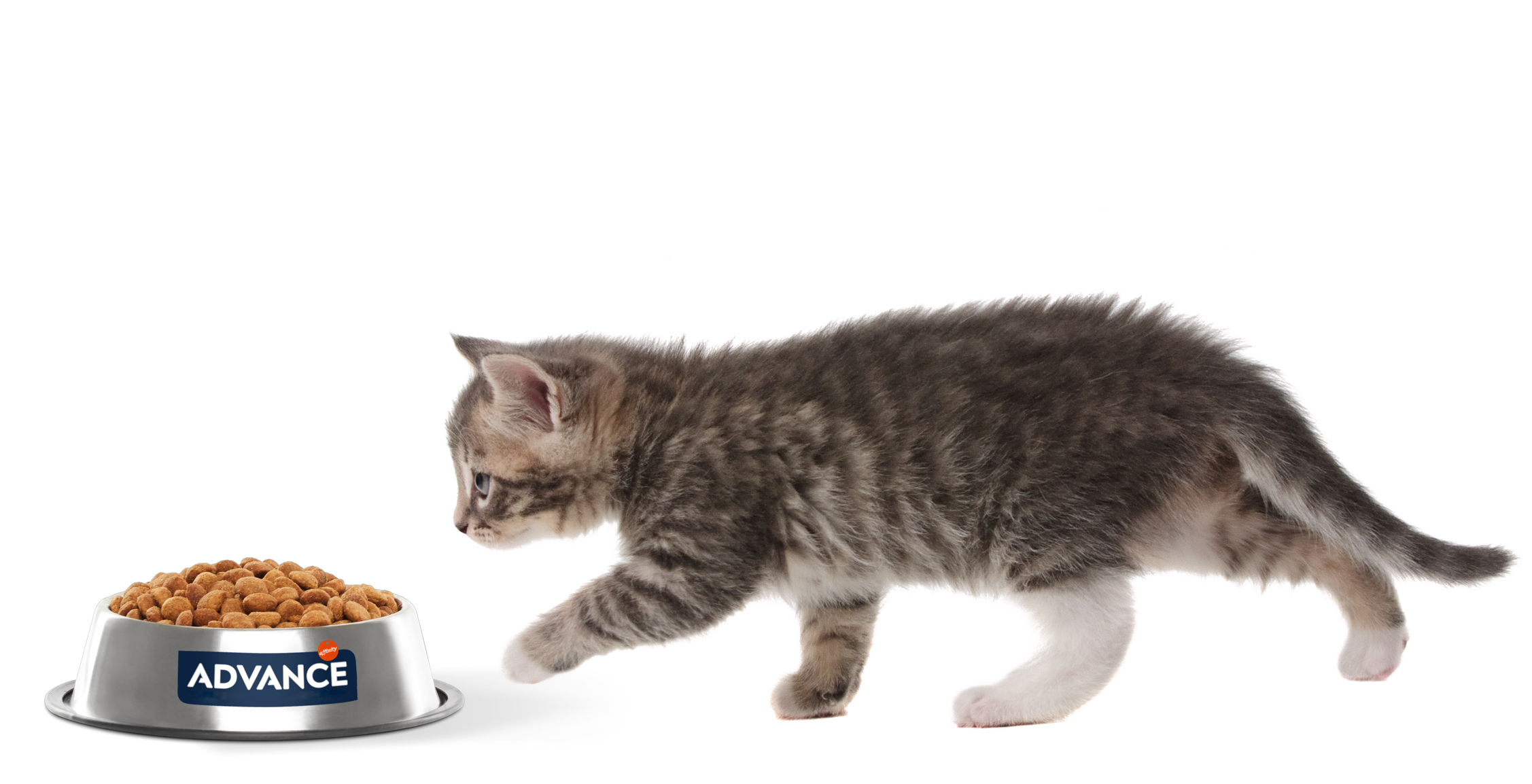
✓ A partir de las cuatro semanas de vida puedes iniciar una transición a la comida sólida para que tanto su sistema digestivo como sus dientes se vayan acostumbrando. Alrededor de las ocho semanas de vida ya puede alimentarse únicamente a base de comida sólida.
✓ Ofrécele a tu gatito una ración adecuada de pienso seco de alta calidad y comida húmeda cada día, en varias tomas o a libre disposición.
✓ Muchos gatos rechazan probar nuevos alimentos en su edad adulta. Para evitarlo, puedes introducir diferentes variedades de alimentos, aptos para gatos, cuando aún son cachorritos.
✓ La hidratación en los felinos es un factor clave para mantener su salud. Por lo que se recomienda tener varios puntos de agua limpia y fresca a diario.
✓ Tanto los comederos como los bebederos de acero inoxidable son la mejor opción. Además, añadir una fuente de agua que suministre agua en movimiento, aumentará su motivación para beber.
FOOD
✓ The ideal thing to do with a kitten is to feed them during their first weeks of life with maternal milk so that they ingest the critical proteins and immunoglobulins required for their immune system to develop properly.
✓ If your adopted kitten is only a matter of a few days old, they will need artificial maternal milk to be administered with a feeding bottle.
✓ Do not give your kitten goats’ or cows’ milk because these could cause significant changes to their digestion.

✓ From four weeks old you can begin a transition to solid food so that both their digestive system and their teeth start to get accustomed to it. From around eight weeks old they can be fed solely on solid food.
✓ Offer your kitten a suitable portion of high-quality dry feed and wet food every day, either at various times or leaving it freely available to them.
✓ Many cats will refuse to try new foods once they reach adult age. To avoid this, you can bring in different types of foods, which are suitable for cats, when they are still little kittens.
✓ Hydration is a key factor to maintaining felines’ health. As such it is advisable to have several clean and fresh water points on a daily basis.
✓ Food and water bowls made of stainless steel are the best option. Also, adding a water source that supplies running water will increase their motivation to drink.
HYGIENE

Bathing
Cats are very meticulous with their personal grooming, which means that generally speaking, you do not need to take charge of the majority of their hygiene.

Looking after the mouth
Milk teeth appear at around three weeks old, and by six weeks they will have a full set of primary teeth. From 3-4 months old these will begin to be replaced by their definitive teeth until, finally, at 6-7 months old they will have their full set of adult teeth.
Moreover, with cats it is important to go over their oral cavity (mucosa, gums and tongue) because some of the most common illnesses in cats show first in this area. For this reason, you should not hesitate to consult your vet about your cat’s oral health

Brushing
A good brushing routine promotes fur and skin health:
• It gets rid of excess dead fur, helping to reduce the amount of fur that they ingest when carrying out grooming that would otherwise end up turning into the famous hairballs.
• It keeps their fur in good condition.
• It is a good time to check over their skin and ensure that they do not have any injuries or parasites.
Getting them used to this from an early age will make the task easier and can strengthen the bond we have with our cat if we do it in a pleasant way. You can reward them each time that they let you do it.

Cleaning the ears
This will help to prevent infections. If you have a long-haired puppy that is lop-eared, pay special attention, because they are prone to a build up of residue. Do it once a month with a damp gauze. Never use cotton buds.

Nail care
Most cats do not need specific care for their nails (claws), because they themselves look after their maintenance thanks to their scratching behaviour. For indoor cats, therefore, we should make sure a scratching post is available to them.
If you need to cut your cat’s claws, it is preferable that you take them to your vet so that they can show you how to do it. You should use nail clippers designed specifically for cats, hold your kitten’s paw and press on the base of it with your thumb. Make very small cuts only to the end of the claw, without reaching the blood vessels, to avoid haemorrhages.

Cleaning the eyes
If necessary, you can wipe a gauze moistened with eye cleaner around their eyes, getting rid of secretions and dirt.

Removal of parasites
Ongoing anti-parasite care, for both internal and external parasites, is very important for your kitten’s health and that of your whole family.
Depending on the kind of life that they lead (whether they go outdoors or not, or whether they have contact with other animals), the pattern that your vet assigns to them can vary.

Vaccination
In the UK at present there are no mandatory vaccinations for cats, with the exception of rabies, which is obligatory if they are going to go abroad. However, the majority of them are important and highly recommended.
Normally, vaccination of kittens begins at approximately 8 weeks old and will finish at around week 16.
Your vet will draw up the most appropriate vaccination schedule for the age and lifestyle of your cat.
